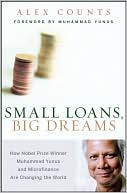List Books » Small Loans, Big Dreams: How Nobel Prize Winner Muhammad Yunus and Microfinance are Changing the World
Category Books
- Fiction Books & Literature
- Graphic Novels
- Horror
- Mystery & Crime
- Poetry
- Romance Books
- Science Fiction & Fantasy
- Thrillers
- Westerns
- Ages 0-2
- Ages 3-5
- Ages 6-8
- Ages 9-12
- Teens
- Children's Books
- African Americans
- Antiques & Collectibles
- Art, Architecture & Photography
- Bibles & Bible Studies
- Biography
- Business Books
- Christianity
- Computer Books & Technology Books
- Cookbooks, Food & Wine
- Crafts & Hobbies Books
- Education & Teaching
- Engineering
- Entertainment
- Foreign Languages
- Game Books
- Gay & Lesbian
- Health Books, Diet & Fitness Books
- History
- Home & Garden
- Humor Books
- Judaism & Judaica
- Law
- Medical Books
- New Age & Spirituality
- Nonfiction
- Parenting & Family
- Pets
- Philosophy
- Political Books & Current Events Books
- Psychology & Psychotherapy
- Reference
- Religion Books
- Science & Nature
- Self Improvement
- Sex & Relationships
- Social Sciences
- Sports & Adventure
- Study Guides & Test Prep
- Travel
- True Crime
- Weddings
- Women's Studies
Small Loans, Big Dreams: How Nobel Prize Winner Muhammad Yunus and Microfinance are Changing the World »

Authors: Alex Counts
ISBN-13: 9780470196328, ISBN-10: 0470196327
Format: Hardcover
Publisher: Wiley, John & Sons, Incorporated
Date Published: April 2008
Edition: (Non-applicable)
Author Biography: Alex Counts
Alex Counts ist Prasident und CEO der Grameen Foundation, einer gemeinnutzigen Stiftung, in Washinton DC, die heute ein weltweites Netz von kleinkreditgebenden Organisationen unterhalt.
Book Synopsis
The stark reality of global poverty—the poorest half of the world's population owns less than one percent of its assets, and that nearly one billion people subsist on less than $1 per day—rarely registers even a ripple in the international media. Western attempts to stem hunger and poverty are often piecemeal and ineffective, applying band-aids rather than finding permanent solutions. But Muhammad Yunus, visionary founder of the Grameen Bank, has demonstrated different and more inclusive ways of approaching the problems that confront humanity. In creating Grameen, he turned the conventional wisdom of traditional financial institutions on its head: instead of seeking out wealthy people with collateral and excluding the poor, Yunus sought out the impoverished and excluded the rich. His approach, known as microfinance, has revolutionized global antipoverty efforts.
In Small Loans, Big Dreams, Alex Counts presents compelling stories of women benefiting from Yunus's microcredit in rural Bangladesh and urban Chicago. He sets the stage by telling the story of Grameen's founding by Yunus, describing the environments in which Grameen Bank and the Full Circle Fund—a bold effort to apply the same principles in Chicago—and their clients operated. He then recounts the experiences of different borrowers in each country, interspersing them with stories of Yunus, his colleagues, and their counterparts in Chicago. These fascinating accounts not only show the power of the strategy, but also prove that it is no panacea that absolves governments and businesses from their obligation to consider the needs of the poor. Instead, microfinance emphasizes that other sectors think about the implications of its success for their own work—which may be based on flawed assumptions about the poor that the success of microfinance has disproved.
Microfinance has the potential to reach truly massive numbers in the years ahead. But in order to grasp future opportunities and challenges, it is essential that people everywhere understand just what it takes to build a large microfinance institution like Grameen Bank, and how this allows for market-based poverty reduction through the principle of self-help. To that end, this book provides a straightforward, inspiring, and accessible guide.
Table of Contents
Foreword vii
Acknowledgments xi
Introduction to the 2008 Edition 1
Introduction to the First Edition 11
Muhammad Yunus-From Vanderbilt to Chittagong 27
The Birth of the Grameen Bank 53
Zianpur Bazaar 83
Les Papillons 115
Amena Begum's Dream 147
Omiyale DuPart 165
The Haldar Para 189
The Maxwell Street Market 215
Krishna Das Bala 241
The Hip Hop Shop 261
Dry Money in a Monsoon 283
The Black on Black Love Festival 301
The Sixteen Decisions 333
"We're Here for You" 359
Epilogue 377
Appendix 385
Notes 387
About the Author 393
Index 395
Subjects
 Professional Finance & Investing
Professional Finance & Investing  Credit & Debt
Credit & DebtBusiness Books
 Professional Finance & Investing
Professional Finance & Investing  Microfinance
Microfinance
